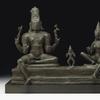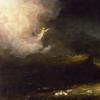John Little: Paintings from 1946 to 1980
- NEW YORK, New York
- /
- June 18, 2012
Spanierman Modern is pleased to announce the opening on June 7, 2012 of Equilibrium: Paintings from 1946 to 1980 by John Little. A pioneering member of the Abstract Expressionist movement, John Little (1907–1984) explored this groundbreaking aesthetic for forty years, creating paintings in which he transposed nature into “a new equilibrium” of form and space. His canvases are characterized by dynamic, explosive energies that are yet restrained by the artist’s propensity for resolution and balance.
John Little was born in Sanford, Alabama, but left for Buffalo, New York, at age fourteen to become an artist. He enrolled at the Buffalo Fine Arts Academy, where in 1927, he was influenced by an important exhibition of modern art organized by the Société Anonyme. Moving that year to New York, Little studied opera and opened his own textile studio. He also focused on his art, studying at the Art Students League under George Grosz and subsequently under Hans Hofmann, whose teachings had a profound impact on him. After serving in the navy as an aerial photographer during World War II, Little began his career as an abstract painter. In the late 1940s and early 1950s, his work projected a surrealist sensibility, as in Suspended Form (1951-52), in which he drew his inspiration from observing birds flocking on the beaches of Wellfleet, Massachusetts.
John Little had his first solo exhibition at the California Palace of the Legion of Honor in San Francisco in 1946. Two years later, his first solo show in New York was held at the Betty Parsons Gallery. The artist had visited the East End of Long Island initially in 1934, as a guest of his friends Lee Krasner and Jackson Pollock. He moved there in 1944, settling in Springs, where he relocated an old barn to a piece of land he had purchased, which became a home for the artist, his wife, and two daughters. Active in the art scene on Long Island, Little established the Signa Gallery in East Hampton in 1957 with his friends Alfonso Ossorio and Elizabeth Parker. During the four years that it existed, the gallery mounted innovative exhibitions and was an important summertime showcase for the best of the New York art scene. In 1957, Little had a two-man exhibition with Pollock at the Guild Hall Museum of Art. (Both Little and Pollock were featured in films by Hans Namuth, showing them at work.)
In the late 1950s, John Little often created thick surfaces through the use of a palette knife, scrapers, and loaded brushes, with which he united his shapes with the movement of his paint. His use of white as a form to create breathing space and open a composition outward may be seen in Resolution (1957). In Earth Forms (1960), Little used wide brushes to create shapes that flow laterally, demonstrating his sensivity to the impact of colors and forms within the picture plane, which he viewed as akin to a magnetic force field.
Fascinated by astronomy since his childhood, John Little was enthralled by the photographs of the moon published in the late 1960s as a result of American and Russian lunar missions, leading up to and following the landing on the moon of Apollo 11 on July 20, 1969. These images, showing close ups of the moon’s surface, were a “motivating idea” for the artist and he named a number of his works for geographic areas of the moon that appeared in the photographs. Breaking apart circular shapes in his paintings, Little explored an entirely new type of landscape, conveying a sense of colliding worlds and dramatic geologic events.
In works of the 1970s such as Festival (1973) and Dark Odds (1976), John Little brought together many strands of his art, exploring the “inter-vibration” of bold colors and striving for synethesis from contradictory forces. Little continued to paint and exhibit extensively throughout his life. In 1982, two years before his death, he was honored with a retrospective exhibition at East Hampton’s Guild Hall Museum. He is represented in numerous public and private collections across the country.
Contact:
Martha CampbellSpanierman Modern
212-832-1400
mcampbell@spanierman.com
53 East 58th Street
New York, New York
inquiry@spaniermanmodern.com
212-832-1400
http://www.spaniermanmodern.com
About Spanierman Modern
Specializing in modern and contemporary artists from the mid twentieth century to the present. Please see our artists represented.
















